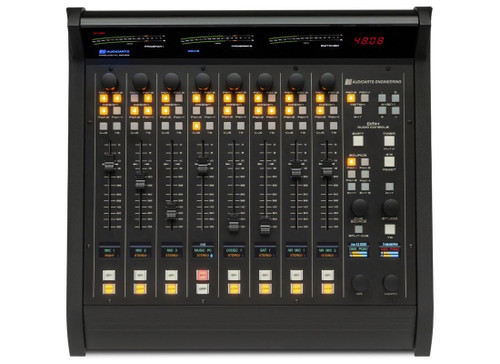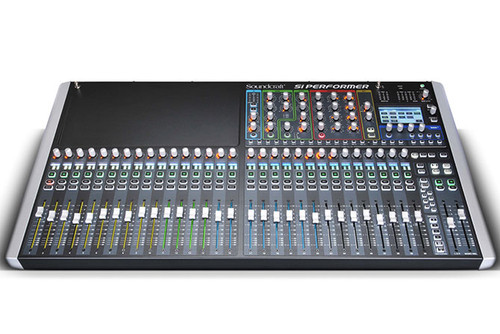Need more? Simply take advantage of all the WheatNet-IP Intelligent Network has to offer.
The DMX control surface is a fully integrated standalone console for on-air and production applications. It is available in an 8-fader (DMX-8) or 16-fader (DMX-16) frame with four program busses and bus-minus on every fader as well as convenient multi-function knob on each channel for adjusting pan, mode, dynamics, and input sources. The console has talkback and cue functions, EQ/dynamics, and control room, studio and headphone monitors, plus LED metering, built-in timer, and four-event recall.
Audioarts Mix Engine uses RJ45 connectors for all audio (StudioHub+ format), logic (WheatNet-IP-format), and network connections, except for the 2 mic preamp inputs (XLR).
With two sizes of control surface (8- or 16-channel) available, DMX puts a lot of radio control into a very small footprint – everything you need to take it to the air.
Connections include Mic Preamps Out; 4 stereo/dual mono analog inputs; 4 stereo/dual mono digital inputs; four stereo Program outputs (both analog and digital); 4 stereo analog Monitor outputs (Control Room, Studio, Cue, and operator headphones); 6-port logic GPIO; Engine Ethernet port; 5-Port Ethernet switch to network the Surface, Engine, and three additional devices.
DMX utilizes WheatNet-IP to access, control, and process any and all audio sources on the network. Each of the Razor I/O Interfaces pictured above provides you with 8 analog, digital, or analog/digital inputs and outputs, as well as logic and Ethernet connections on RJ45 connectors. Additionally, the Analog Razor gives you a pair of mic preamps, complete with phantom power and processing presets.
DMX can also tap the full power of the WheatNet-IP Intelligent Network, allowing you to utilize BLADE interfaces, to access, control, and process any and all audio sources on the network, utilizing the award-winning tools built into every BLADE. Through AES67, DMX is compatible with similarly equipped third party gear, providing functionality for your facility that is unequalled. Additionally, all software, such as ScreenBuilder, IP Meters, WheatNet-IP Driver, Navigator, and more are at your disposal to create workflows that can address your exact needs.
• Standalone production or on-air console with local inputs and outputs
• 5-port Ethernet switch built into Audioarts Mix Engine - no need for an external switch
• Control surface sizes for 8-, 16-fader channels
• WheatNet-IP protocol with 1Gb connectivity - any source to any fader
• Bus Minus (N-1) on each input channel
• Four program output busses
• Four event buttons for recalling entire console setups at the touch of a button
• Pre-programmed processing presets for mic/voice
• Control room, studio, and headphone jack (with built-in amplifier w/level control)
• Full EQ functions (4-band parametric with high/low pass and high/low shelving) and full dynamics (compression, limiting, and expansion) on every channel
• Multi-function channel-encoder knob with OLED display on each channel for control of EQ, dynamics, sources, pan, mode, and more
• Talkback and cue functions
• Built-in timer
• Six logic GP I/O ports for network control
• 100% WheatNet-IP compatible with all BLADEs, Consoles, Processors, and Software
• Audioarts Mix Engine is configured: 2 mic inputs on XLRs, with all additional I/O on RJ-45 connectors: 4 analog inputs, 4 digital inputs, 4 analog outputs, 4 digital outputs, 2 analog mic outputs, Headphone output, Cue output, Studio output, and Control Room output. There are also 5 ethernet ports that will interface directly with optional I/O Razor Interfaces, and a 1 Gb ethernet port for networking.
• Optional Razor I/O Interfaces can expand the system I/O with 8 stereo or 16 mono in and/or out; available in analog, digital or analog/digital version
• No External Switch Needed
With the Audioarts Mix Engine, we've provided five Ethernet ports for interfacing the Surface, the Engine, and your PC for use with Audioarts Navigator or Audioarts Surface Setup, as well as optional devices such as VoxPro PC, a media server, or a couple of Razor I/O units for expansion. Essentially acting as a built-in switch, this keeps IT management and procurement costs down while making it dead simple to expand your AoIP network. Of course, if you DO want to expand even further and add more DMX consoles, you can add a managed gigabit switch and be off and running to a larger network. And, it's fully WheatNet-IP compatible.
• Source and Program
Any channel can be assigned to one or more program output busses, making your material available to an on-air feed as well as an internet stream, for instance. Source Pgm Select Any input can be called up on any channel on the DMX. This means, for instance, the feed you’ve got plugged into input 7 on the back of the Engine (or ANY Razor I/O Interface) can show up on channel 2…or any other channel. Same with any input.
• Full Real-Time Parametric EQ and Dynamics Processing on Every Channel
The DMX has 4 fully parametric EQ bands with peak/shelf control for the low and high bands plus high and low pass filters - on every channel. Same with compression, limiting, and expansion dynamics control - a full suite on every channel. All available at all times in real-time from the console - turn the knob, see the values on the OLED display, and hear the change as you go. When editing, the functions spill out across channels on the DMX letting you see the entire picture at once. When you are done editing, just close out and the board goes back normal display functions. With full color OLED displays and color-coded functions, you can see all your settings at a glance. Shown are just a sampling of the displays available on the DMX.
• Tough Construction
We’ve built the DMX to withstand years of use and abuse. The finest components and the most reliable construction come together to create a surface that any station would love to have in their production suite, control room, or on-air.
• Mix-Minus/Direct Output/TalkbackCue
Each fader has a dedicated Mix-Minus output that includes all active faders on its selected source bus, except for itself. These auto generated monaural Mix-Minus signals may be routed to feed telephone hybrids or other devices as required. Alternately, these outputs may be set to provide a separate direct output from that channel only, consisting of the source assigned to that channel. Each channel has a talkback that will interrupt the feed to that mix-minus.





